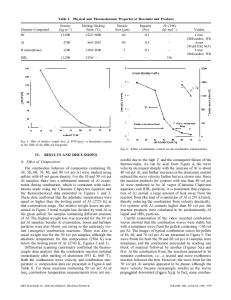Combustion synthesis of MoSi 2 -Mo 5 Si 3 composites
- PDF / 1,530,713 Bytes
- 7 Pages / 576 x 792 pts Page_size
- 46 Downloads / 559 Views
Thermochemical calculations were carried out for the Self-propagating High-temperature Synthesis (SHS) of MoSi 2 , M05S13, and their composites. Adiabatic temperatures and the amounts of liquid phases formed at the adiabatic temperature were calculated for different initial temperatures. These materials were prepared from elemental powders of Mo and Si by the thermal explosion mode of SHS. The products were characterized by x-ray diffraction, scanning electron microscopy, and microhardness. The larger particle morphology of MoSi2 and the MoSi 2 -Mo 5 Si 3 composite and the finer morphology of Mo 5 Si 3 can be explained in terms of the presence of transient liquid phase at the adiabatic temperature. The morphology of fracture surface of MoSi2 shows intergranular fracture, while M05S13 and the M0S12-M05S13 composite show transgranular cleavage fracture.
I. INTRODUCTION Intermetallics based on silicides are emerging as replacements for the conventional superalloys due to their high melting points, excellent oxidation resistance, and brittle-to-ductile transformation (BDT).1"11 MoSi2 has long been in use for high-temperature heating elements due to its excellent oxidation resistance. It becomes ductile above its BDT temperature of about 900 °C.2 This property not only makes the failure behavior of MoSi2 more predictable, but also makes it amenable to conventional metallurgical processing like hot deformation. However, due to the same property, above 900 °C the strength of MoSi2 decreases with increasing temperature. Both ambient temperature fracture toughness and elevated temperature strength need to be improved before MoSi2 can be put to application. The high-temperature strength of MoSi2 can be improved by alloying with other silicides and/or reinforcing it with particulates or fibers.5'12'13 Anton and Shah14 carried out compressive creep tests on several intermetallics including MoSi2 and M05S13. They have reported that M05S13 maintained very high creep resistance with increasing temperature. It has been reported by Gibala et al.15 that Mo 5 Si 3 strengthens MoSi2 in the temperature range 1000-1300 °C. Schwarz et al.8 described the preparation of MoSi2-based composites by mechanical alloying. They have reported a fourfold improvement in yield strength for MoSi2 + Mo5Si3 composites compared to MoSi 2 . The compositions prepared by the authors, 27 and 50 mole % Mo 5 Si 3 , are hypoeutectic, with higher amounts of Mo 5 Si 3 compared to MoSi 2 . Recently Mason and Van Aken have shown that the hardness of MoSi 2 -Mo 5 Si 3 eutectics increases with a decrease in the MoSi2 grain size.16 2620
http://journals.cambridge.org
J. Mater. Res., Vol. 9, No. 10, Oct 1994
Downloaded: 04 Apr 2015
Self-propagating High-temperature Synthesis (SHS), also known as combustion synthesis, is gaining importance as a technique for producing powders and near net shape components of metals, intermetallics, ceramics, and their composites.17 Preparation of MoSi2 by SHS was reported earlier.18"20 SHS is capable of producing composites with hom
Data Loading...











